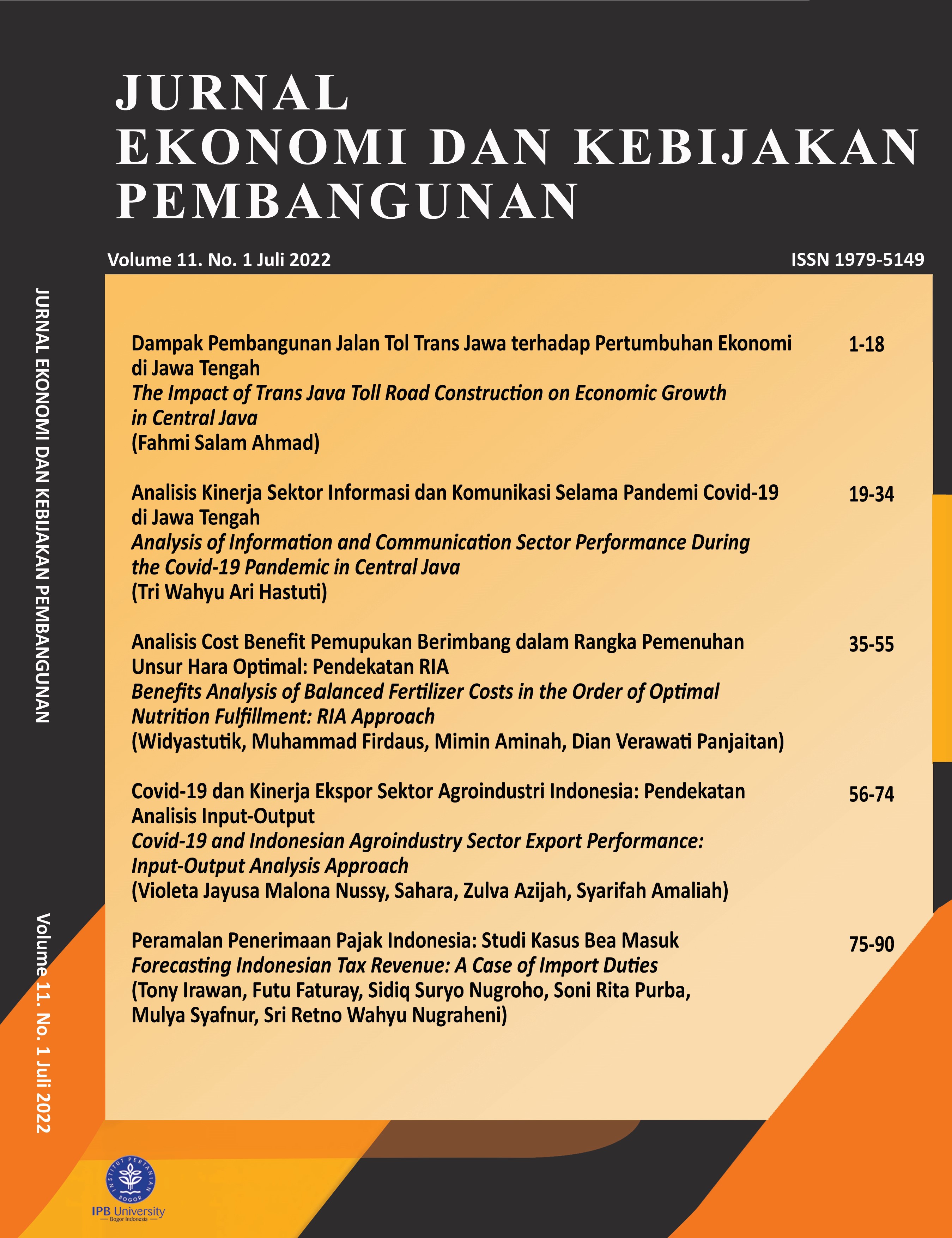Benefits Analysis of Balanced Fertilizer Costs in the Order of Optimal Nutrition Fulfillment: RIA Approach IPB University
Abstract
The government prepares recommendations for optimal fertilization according to plant needs, optimum for increasing production, increasing fertilization efficiency, soil fertility, and avoiding environmental pollution. However, the condition of agricultural land in Indonesia shows an excess of P and K nutrients from NPK 15-15-15. As a result, the soil becomes saturated, wasteful, and import costs are high in the long term. For this reason, the government reformulated from NPK 15-15-15 to 15 10 12. So the purpose of this research is to find out the benefits and costs of changing this formulation using the RIA (Regulatory Impact Assessment) method with three scenarios. Based on calculating the benefits and costs of the NPK fertilizer formulation that provides the most benefits, scenario 3 uses the NPK 15 10 12 formula with straw immersion innovation and soil and plant test equipment. The total benefit obtained is Rp. 323,988,364.65. Straw as a source of Potassium (K), Silica (Si), and microelements and a source of energy for soil microorganisms are recommended to be returned to paddy fields to increase fertilization efficiency soil fertility, improve, and maintain soil health and environmental quality. The effectiveness of the reformulation policy of NPK 15 15 15 to NPK 15 10 12 needs to be supported by advocacy to farmers regarding the benefits that will be obtained when implementing balanced fertilizers to get optimal crop yields. Lessons from farmers who successfully buried straw that impact rice production and productivity must be disseminated to other farmers.
References
Agustian A, Hermanto, Kariyasa K, Friyatno S, dan Hidayat D. 2017. Kajian Kebijakan Subsidi Pupuk: Harga, Distribusi dan Dampaknya terhadap Permintaan Pupuk dan Produksi Tanaman Pangan. Pusat Sosial Ekonomi dan Kebijakan pertanian, Sekretariat Jenderal Kementerian Pertanian.
Anwar. 2021. BPS Ungkap Indonesia Masih Impor Beras 356.286 Ton di 2020. https://money.kompas.com/read/2021/03/29/140638626/bps-ungkap-indonesia-masih-impor-beras-356286-ton-di-2020?page=allhttps://ekonomi.bisnis.com/read/20210831/12/1436057/dpr-soroti-impor-beras-41000-ton-begini-realisasi-impor-beras-premium#:~:text=Merujuk%20data%20sementara%20BPS%2C%20Indonesia,senilai%20US%2411%2C23%20juta.&text=Lembaga%20legislatif%20menyebutkan%20terdapat%20impor,Badan%20Pusat%20Statistik%20(BPS).
[BPS] Badan Pusat Statistik (a). 2021. https://www.bps.go.id/indicator/53/1498/1/luas-panen-produksi-dan-produktivitas-padi-menurut-provinsi.html. Akses Tanggal 3 November 2021.
[BPS] Badan Pusat Statistik (b). 2021. https://www.bps.go.id/indicator/36/1034/2/rata-rata-harga-gabah-bulanan-menurut-kualitas-komponen-mutu-dan-hpp-di-tingkat-petani.html
[BPS] Badan Pusat Statistik (c). 2021. https://www.bps.go.id/indicator/20/295/1/rata-rata-harga-beras-di-tingkat-perdagangan-besar-grosir-indonesia.html
[BPS] Badan Pusat Statistik (d). 2021. https://www.bps.go.id/indicator/36/1034/2/rata-rata-harga-gabah-bulanan-menurut-kualitas-komponen-mutu-dan-hpp-di-tingkat-petani.html.
Hadiyantono. 2018. BPS revisi konversi GKG ke beras sekarang jadi 64,02%. https://industri.kontan.co.id/news/bps-revisi-konversi-gkg-ke-beras-sekarang-jadi-6402. Akses Tanggal 30 Oktober 2021.
Hartono, A., S. Anwar, A. Satwoko, K. Koyama, T. omoto, A. Nakao, and J. Yanai. 2015. Phosphorus fractions of paddy soils in Java, Indonesia. J. ISSAAS. 21 (2): 20-30.
Hartono, A., B. Barus, S. Janottama, and E. Saragih. 2021. Smart farming using SIPINDO powered by SMARTseeds: fertilizers recommendation for chili, tomato and cucumber. IOP Conference Series: Earth and Environmental Science. 694 (1): 012017
Hatta, M. 2021. Kebijakan, Program dan Kegiatan Direktorat Pupuk dan Pestisida TA 2021.
Husnain, D Nursyamsi, dan J Purnomo. 2015. Penggunaan bahan agrokima dan dampaknya terhadap pertanian ramah lingkungan. Teknologi pengelolaan jerami pada lahan sawah terdegradasi.
Kariyasa. 2021. Kebijakan Subsidi Pertanian. Kementerian Pertanian, disampaikan pada Seminar Dewan Guru Besar (DGB) IPB University, 17 Juni 2021.
Kasno, A. Nurjaya, dan D. Setyorini. 2003. Status C-organik lahan sawah di Indonesia. Konggres Himpunan Ilmu Tanah Indonesia (HITI) di Universitas Andalas, Padang.
Kementan. 2020. Stok Beras Aman Sampai 2020. https://www.pertanian.go.id/home/?show=news&act=view&id=4108. Akses Tanggal 3 November 2021.
Ladiyani. 2021. Optimalisasi Formula dalam Pemupukan. Balittanah Kementan, , disampaikan pada Seminar Dewan Guru Besar (DGB) IPB University, 16 September 2021.
Mangkoesoebroto, Guritno. 2001. Ekonomi Publik. Edisi Ketiga, Cetakan Kesepuluh BPFE Yogyakarta.
Mulyana, N. 2015. Teknik/Metode Advokasi Rekomendasi Kebijakan. Disampaikan pada Worskhop Rekomendasi Kebijakan Pusat Teknologi Terapan Kesehatan dan Epidemiologi Klinik Badan Litbang, 27 Agustus 2015
[OECD] Organisation for Economic Co-operation and Development. (2020). Regulatory Impact Analysis. https://www.oecd.org/regreform/regulatory-policy/ria.htm. Akses Tanggal 8 April 2021.
Sharma, R. 2004. Pengantar Advokasi. Yayasan Obor Indonesia. Jakarta.
Stiglitz, Joseph E. 2000. Economics of The Public Sector. Third Edition. W.W. Norton & Company, New York.
Soekartawi. 2003. Teori Ekonomi Produksi dengan Pokok Bahasan Analisis CobbDouglas. Jakarta : PT RajaGrafindo Persada.
Sudarman. 1999. Teori Ekonomi Mikro, Jilid I, BPFE, UGM, Yogyakarta.
Sudarsono. 1998. Ekonomi Sumber Daya Manusia. Jakarta. Universitas Terbuka.
Susanto, B; Hartono, A; Anwar, S; Sutandi, A; Sabiham, S. 2018. Model Hubungan Fraksi P dengan Sifat Kimia Tanah Sawah pada Tiga Kelompok Bahan Induk Berbeda di Jawa Barat. Jurnal Tanah dan Iklim Vol. 42 No. 2, Desember 2018: 135-151.
Yanai, J; Omoto, T; Nakao, A; Koyama, K; Hartono, A; Anwar, S. 2014. Evaluation of nitrogen status of agricultural soils in Java, Indonesia. Soil Science and Plant Nutrition (2014), 60, 188–195.
Authors

This work is licensed under a Creative Commons Attribution-ShareAlike 4.0 International License.
The authors who publis article(s) in Jurnal Ekonomi and Kebijakan Pembangunan have to understand and agree that the copyright of article published is owned by Jurnal ekonomi and Kebijakan pembangunan including to reproduce, distribute and sell this journal to public.

